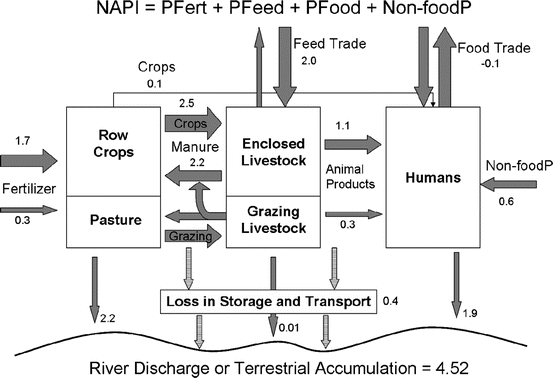Russell,M.J., Weller,D.E., Jordan,T.E.,
Sigwart,K.J. and Sullivan,K.J.(2008): Net anthropogenic phosphorus
inputs: spatial and temporal variability in the Chesapeake Bay
region. Biogeochemistry, 88, 285-304.
『正味の人為源リンのインプット:チェサピーク湾地域における時空間変動』
『Abstract
We estimated net anthropogenic phosphorus inputs (NAPI) in the
Chesapeake Bay region. NAPI is an index of phosphorus pollution
potential. NAPI was estimated by quantifying all phosphorus inputs
and outputs for each county. Inputs include fertilizer applications
and non-food phosphorus uses, while trade of food and feed can
be an input or an output. The average of 1987, 1992, 1997, and
2002 NAPI for individual counties ranged from 0.02 to 76.46 kg
P ha-1 year-1. The overall area-weighted
average NAPI for 266 counties in the region was 4.52 kg P ha-1
year-1, indicating a positive net phosphorus input
that can accumulate in the landscape or can pollute the water.
Large positive NAPI values were associated with agricultural and
developed land cover. County area-weighted NAPI increased from
4.43 to 4.94 kg P ha-1 year-1 between 1987
and 1997 but decreased slightly to 4.86 kg P ha-1 year-1
by 2002. Human population density, livestock unit density, and
percent row crop land combined to explain 83% of the variability
in NAPI among counties. Around 10% of total NAPI entering the
Chesapeake Bay watershed is discharged into Chesapeake Bay. The
developed land component of NAPI had a strong direct correlation
with measured phosphorus discharges from major rivers draining
to the Bay (R2=0.81), however, the correlation with
the simple percentage of developed land was equally strong. Our
results help identify the sources of P in the landscape and evaluate
the utility of NAPI as a predictor of water quality.
Keywords: Anthropogenic; Budgets; Nutrients; Phosphorus; Watershed』
Introduction
Methods
Study area
Phosphorus budgets
Phosphorus fertilizer application
Net P import or export in human food and animal feed
Food and feed consumption and non-food P
Crop production
Grazing livestock
Pasture production consumed by grazers
Livestock products for human consumption
Geographic and temporal analysis
Proxy variables for NAPI
Discharge of NAPI
Results
County characteristics
Net anthropogenic phosphorus inputs and geographic differences
Temporal changes
Phosphorus fluxes
Proxy variables
Percentage of NAPI discharged from Chesapeake Bay watershed
Discussion
Decoupled production and consumption
Trade of feed and food
Other possible fates of P
NAPI's relationship to nutrient discharges
Temporal trends
Conclusion
References
ホームへ
